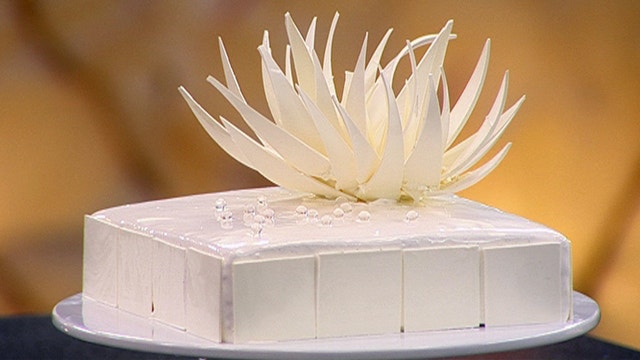Back
Zumbo V8 Cake

- Steps
- Ingredients
Ingredients
Vanilla crème chantilly
Toasted vanilla brulee
Vanilla water gel
Vanilla glaze
Vanilla ganache
Brown sugar crumble
Vanilla macaron
Vanilla dacquoise
Vanilla chiffon cake
Vanilla almond crunch
Vanilla syrup
White chocolate flower and tiles
Select All
Steps
- Preheat oven to 160°C.
- To make the roasted vanilla beans, place 2 vanilla beans in oven until burnt and charcoal in texture. Grind to a fine powder in a mortar and pestle or spice grinder. Cover and set aside.
- To make the pure almond paste, place 100g blanched almonds on a baking tray and bake for 10 minutes or until deep golden. Grind to a coarse paste. Cover and set aside.
- To make the vanilla crème chantilly, cut gelatine into small squares, soak in the cold water. Place cream, vanilla and sugar in a saucepan and bring to the boil. Remove from the heat and allow to cool to 70-80°C, and then stir through the gelatine and water mixture until dissolved. Place in a container, cover the surface with cling wrap and place in the fridge.
- For the toasted vanilla brulee, mix yolks and sugar in a bowl by hand with a whisk until just combined. Add cream and vanilla bean to a small saucepan and bring to the boil, pour a little over the eggs while stirring, then add the remaining liquid including vanilla bean. Puree with a hand blender until smooth and pour into a shallow baking tray about 25 x 38cm. Place into the oven and cook until just set, about 10 minutes, then increase oven to 200°C and bake until it forms a golden brown crust, about 5 minutes. It should look slightly split when removed from the oven. Scrape mixture into a thermomix, blender, or small food processor and blend to a smooth paste. Set aside in a small bowl, covering the surface of the brulee with cling wrap so it doesn’t form a skin. Reduce oven temperature to 160°C.
- To make the vanilla water gel, place a lined 18cm square cake tin in the fridge to chill. Boil all ingredients in saucepan whilst whisking until dissolved and mixture starts to thicken. To test if set, drop about a teaspoon of liquid into a metal bowl, it should thicken slightly. It will thicken on cooling. To speed up cooling, pour into a metal bowl and set aside for 5 minutes. Pour into chilled cake tin and place in the freezer until solid, about 30 minutes. Remove from mould and keep gel in freezer.
- For the vanilla glaze, soak the gelatine leaves in cold water until softened. Drain, squeezing out any excess water. Boil glucose, water and sugar until 165°C, brushing around the sides of the saucepan with a pastry brush dipped in cold water as you go. Do not allow caramel to take on any colour. In another saucepan, bring cream and vanilla seeds to boil and then add to the sugar syrup. Mix through, then allow to cool to 70°C and add softened gelatine, stirring well. Add miroir glaze and titanium dioxide and blend well. Strain, then freeze until set. Reheat to 35°C when glazing the cake.
- For the vanilla ganache, place all ingredients in a blender and mix until smooth and creamy. Cover closely with cling wrap and set aside until needed.
- To make the brown sugar crumble, place all ingredients in an electric mixer and beat mix until dough forms. ‘Grate’ through a cooling rack with a lined baking tray sitting underneath to catch the crumble then bake in the oven for about 10 minutes until golden.
- To make the vanilla macaron, draw an 18cm square on a piece of baking paper placed on a baking tray. Using an electric mixer or hand beaters, whisk egg whites on high speed until soft peaks form then slowly add pure icing sugar, checking it has dissolved in between additions until you have stiff glossy peaks. Stir through TPT with vanilla seeds. Spoon mixture into a piping bag fitted with a 5mm nozzle. Pipe into the pencilled frame using a continuous snaking motion to fill the entire square. Let a skin form and then bake for 10 minutes at 160°C until golden. Remove from oven, slide baking paper off tray and place on kitchen bench. Increase oven temperature to 180°C.
- To make the vanilla dacquoise, draw an 18cm square on a piece of baking paper placed on a baking tray. In an electric mixer fitted with whisk attachment, whisk egg whites on high speed until soft peaks form then slowly add caster sugar, beating until you have stiff glossy peaks. Mix almond meal with icing sugar, vanilla seeds and extract, gently fold through egg whites. Spoon into a piping bag fitted with a 5mm nozzle. Pipe into the pencilled frame using a continuous snaking motion to fill the entire square. Dust with icing sugar, let sit 2 minutes then dust again. Bake at 180°C 10-12 minutes or until golden. Remove from oven, slide baking paper off tray and place on kitchen bench. Reduce oven temperature to 160°C.
- To make the vanilla chiffon cake, draw an 18cm square on a piece of baking paper placed on a baking tray. Mix flour, roasted vanilla bean powder, egg yolks, brown sugar, water and oil in a bowl until combined. Whisk egg whites in an electric mixer on high speed until soft peaks form then slowly add the sugar and rice flour, beating until you have stiff, glossy peaks. Fold the meringue through the batter gently. Spoon into a piping bag fitted with a 5mm nozzle. Pipe into the pencilled frame using a continuous snaking motion to fill the entire square. Bake in the oven set at 160°C until golden, about 15 minutes.
- To make the vanilla almond crunch, melt milk chocolate, add almond praline and the pure almond paste and mix well. Melt butter and take to nut brown (noissette) stage. Add crumble and fueilletine flakes and mix through praline mixture, then fold through burnt butter, followed by toasted almonds, crushed vanilla beans, sea salt and scraped vanilla seeds. Smooth a 5mm layer over vanilla dacquoise and set aside.
- To make the vanilla syrup, bring all ingredients to the boil, then allow to cool.
- To make the white chocolate tiles and flower, bring 5cm of water in a medium saucepan to the boil, turn off the heat and sit a metal bowl with 300g of the chocolate over the water. Stir until just melted then remove bowl to the bench and add about 100g more chocolate to bring the temperature down. Stir vigorously until the chocolate has melted, if the chocolate does not feel cold to the touch, add the remaining 100g chocolate to bring down the temperature. Add titanium dioxide and mix well. Keep stirring well to remove all lumps. If the chocolate mixture feels cold to the touch, spread a small, thin layer onto a small piece of baking paper. Set aside for about 3-4 minutes, it will start to harden if it is tempered correctly. If the chocolate becomes too thick and the temperature is too low, gently reheat the mixture in the bowl set over the saucepan of steaming water, but it still needs to be cold.
- When the chocolate is tempered, to make the flower, spread a thin layer, about 2-3mm thick on 2 pieces of acetate (30 x 40cm) using a large palette knife. Once the chocolate has almost set, on one sheet of acetate carefully mark 3 strips lengthways on the strips, about 7-9cm-wide. Mark thin triangles in each strip. These form the flower petals. Place a piece of baking paper over the top, and wrap around a rolling pin or similar cylinder and allow to completely harden.
- On the other sheet use a ruler to mark out 4 ½ cm squares. Place a piece of baking paper over the top and invert onto a board or clean work surface to completely harden.
- To assemble the cake, in a 20cm acetate-lined straight-sided cake tin spread a 5-10mm layer of Chantilly crème around base and sides of tin. Chill in freezer until firm. Lay vanilla gel at the base of the tin and smear with a tiny amount of brulee so that macaron layer will stick to the gel. Lay macaron layer over brulee smear. Cover macaron layer with an even 5mm of brulee. Place chiffon cake over brulee layer. Brush chiffon cake with a little vanilla syrup. Spread a 5mm layer of ganache over chiffon cake. Invert the dacquoise/crunch layers so the vanilla almond crunch layer is sandwiched next to the ganache and the dacquoise is facing up. The dacquoise will become the base of the cake.
- Fill in any gaps with Chantilly cream, then place in the freezer for 30-60 minutes until firm. Place a large piece of cling wrap on the bench and place a cooling rack on top. Remove the cake from the chiller and invert onto the cooling rack. Heat sides of cake tin gently with a blow torch to help release the mould from the cake. Remove any acetate. Smooth top and sides if necessary with a palette knife. Pouring generously and using a palette knife, spread the vanilla glaze evenly over the top and sides, completely covering the surface. Using a large palette knife transfer the cake to a cake stand and place the chocolate tiles around the cake.
- To assemble the flower spread a small amount of melted tempered chocolate onto a small piece of baking paper and use this as a base to stick the petals, starting in the centre, working outwards to create a flower. Using choco-cool will help ‘fix’ the petals in place and firm up the chocolate base. Place chocolate flower on top of the cake and decorate the top of the cake with a few sugar spheres.
Notes
Please note - you will need precision scales. The vanilla crème chantilly, vanilla glaze, brown sugar crumble, and vanilla syrup can all be made ahead of time.
























